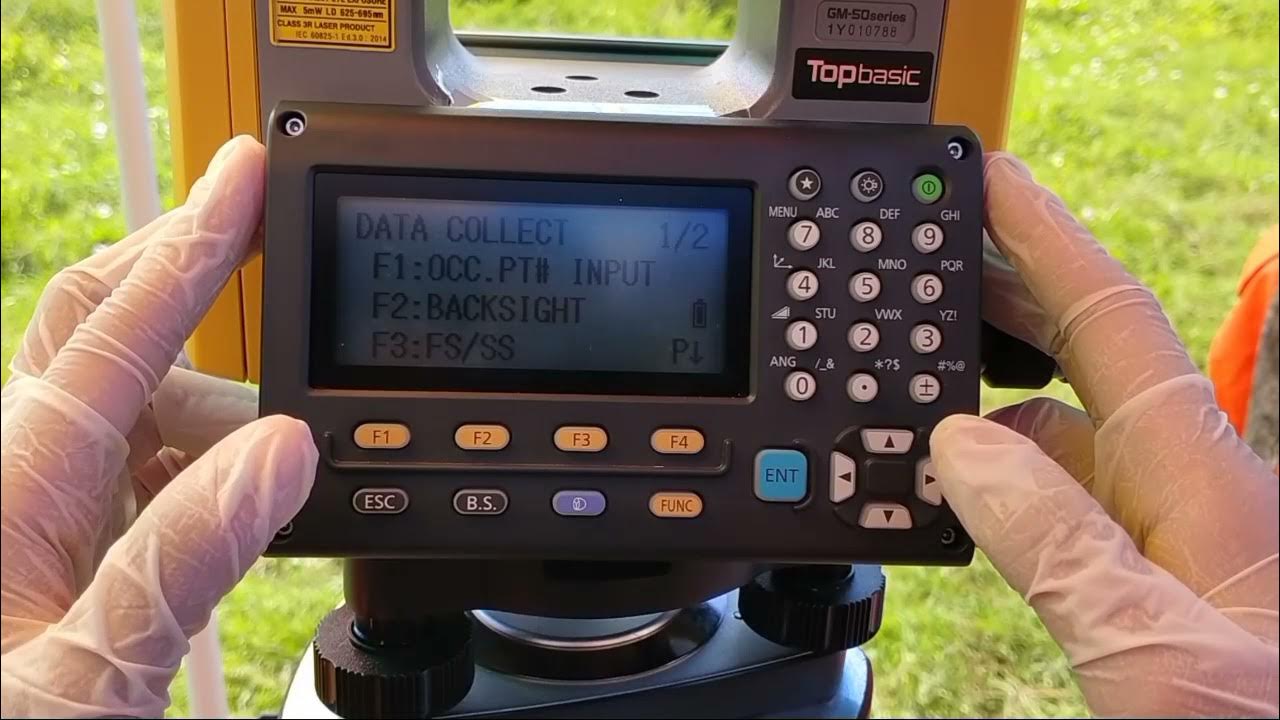Theodolite - Measuring Angles
Summary
TLDRThis instructional script details the setup and use of a theodolite for precise angle measurements in surveying. It covers tripod leveling, theodolite mounting, and bubble level adjustments for accuracy. The tutorial explains the use of adjustment knobs for both vertical and horizontal axes, recording angles in face left and right modes to ensure calibration, and focusing techniques to minimize parallax. It also describes the use of an optical plummet for aligning the instrument over a specific point and measuring distances between surveying stations.
Takeaways
- 🧰 Once the tripod is level, attach the theodolite using the locking screw, ensuring it's finger tight.
- 🔧 Use the three adjustment screws to center the bullseye level, adjusting two screws together and the third separately.
- 📐 The theodolite has a secondary bubble level for higher accuracy; align it within the markers by turning the instrument 90 degrees and repeating the adjustment.
- 🔍 The theodolite includes an eyepiece, sight, focus rings, and several adjustment knobs for precise targeting and measurement.
- 🔒 The vertical and horizontal adjustment knobs have locks that must be engaged for fine adjustments to work.
- 🔢 For angle measurement, use face left and face right modes to eliminate calibration issues by averaging measurements from both modes.
- 🔭 Focus the crosshairs through the eyepiece using a piece of paper to ensure sharpness and reduce parallax.
- 🎯 Use the sight on top of the instrument for initial targeting, then fine-tune through the eyepiece with horizontal and vertical locks applied.
- 📏 Record horizontal angles on the booking sheet, starting with zeroing the instrument and recording measurements at different targets.
- 📊 Average the face left and face right measurements to calculate the final angle for further calculations.
Q & A
What is the first step in setting up a theodolite?
-The first step is to ensure the tripod is level, then place the theodolite on top of the tripod using the locking screw, making sure it is finger tight but not over-tightened.
How do you adjust the bullseye level on a theodolite?
-Use the three adjustment screws to bring the bullseye level into the center circle. Two screws are used together to move the bubble in or out, and the single screw is used to center the bubble directly.
What is the purpose of the secondary bubble level on the theodolite?
-The secondary bubble level is set to a higher degree of accuracy and is used to ensure the instrument is set up correctly for precise measurements.
How do you ensure the secondary bubble level is correctly aligned?
-Adjust the instrument using the two adjustment screws until the bubble is between the two markers. Then, turn the instrument 90 degrees and repeat the procedure using the single adjustment screw.
What are the functions of the adjustment knobs on the eyepiece of a theodolite?
-The adjustment knobs on the eyepiece are used for focusing the crosshairs and adjusting the vertical and horizontal angles of the theodolite.
Why is it necessary to lock the vertical adjustment before making fine adjustments?
-The vertical lock prevents the instrument from moving in a vertical manner, allowing for precise targeting of the prism and accurate angle measurements.
What is the significance of using both face left and face right modes when measuring angles with a theodolite?
-Using both modes helps eliminate any calibration issues with the instrument by measuring the same angle from two different orientations.
How do you reduce parallax when using a theodolite?
-Hold an A4 page in front of the lens and adjust the focus on the eyepiece back and forth until the crosshairs are sharp and in focus.
What is the purpose of the optical plummet on a theodolite?
-The optical plummet allows the user to see a point on the ground directly beneath the prism, useful for setting up over a known surveying point or measuring distances between two points.
How do you record angles in a booking sheet when using a theodolite?
-Record the angles in a U-shape pattern, making two measurements for each angle in both face left and face right modes. Calculate the average of the two measurements for each angle to use in further calculations.
What is the process for measuring the distance between two points using a theodolite's optical plummet?
-Align the optical plummet with a known point, have a colleague mark the point on the ground, repeat at a second station, and then measure the distance between the two marked points using a tape measure.
Outlines

Esta sección está disponible solo para usuarios con suscripción. Por favor, mejora tu plan para acceder a esta parte.
Mejorar ahoraMindmap

Esta sección está disponible solo para usuarios con suscripción. Por favor, mejora tu plan para acceder a esta parte.
Mejorar ahoraKeywords

Esta sección está disponible solo para usuarios con suscripción. Por favor, mejora tu plan para acceder a esta parte.
Mejorar ahoraHighlights

Esta sección está disponible solo para usuarios con suscripción. Por favor, mejora tu plan para acceder a esta parte.
Mejorar ahoraTranscripts

Esta sección está disponible solo para usuarios con suscripción. Por favor, mejora tu plan para acceder a esta parte.
Mejorar ahoraVer Más Videos Relacionados

3 Menit Langsung Bisa Theodolite

Pengukuran Poligon Tertutup dan Detail pada Theodolite

CARA PENGOPRASIAN ALAT THEODOLIT (JOB I)

ENGENHARIA TOPOGRAFIA TEODOLITO - Tutorial - Medida Indireta de Distância e Diferença de Nível

ILMU UKUR TANAH ALAT UKUR THEODOLITE

Cara Pengukuran Detail Situasi dengan Alat Total Station Topcon GM-55
5.0 / 5 (0 votes)
